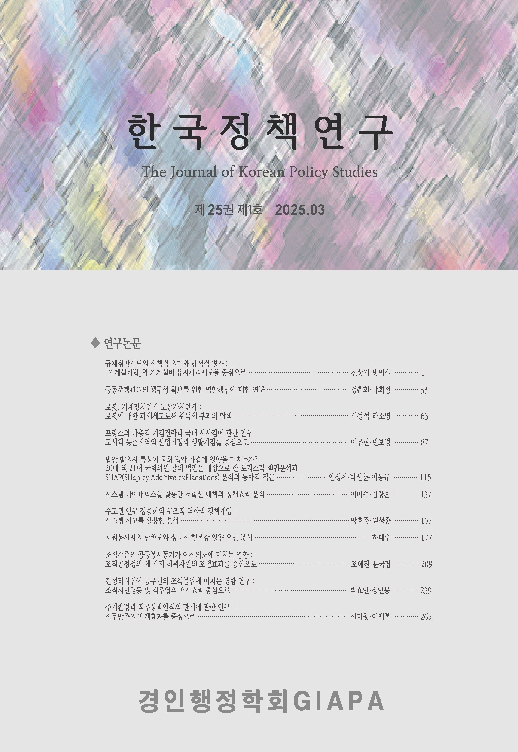수도권 인구 집중화의 구조적 역학과 정책개입: 시스템 사고를 활용한 분석
Structural dynamics and policy interventions of metropolitan population concentration: Analysis using system thinkings
- 창간연도
- 2002년 2월
- ISSN
- (Print)1598-7817 , (Online)2713-6744
- 등재사항
- KCI등재(2019.01 ~ 현재)
- 수록권호
- 제25권 1호
- 발행일
- 2025.03
- 수록논문
- 11 articles
- 유형
- 학술저널
- 주제
- 사회과학
- 발행기간
- 2002.02 ~ 2025.09
- 발행주기
- 연 4회(계간)
- 총 권호 수
- 77 volumes
- 총 논문 수
- 752 articles
초록
최근 수도권 인구 집중화 현상은 상당한 악순환의 고리를 나타내고 있으며, 우리 사회에서 이러한 현상은 마치 일종의 신념처럼 여겨진다. 이러한 수도권 인구 집중화 현상이 가속화됨에 따라 비수도권의 국·공유재산 등 지역 인프라가 가용자산으로 활용되지 않고 있다. 그럼에도 중앙정부 및 지방자치단체 차원에서 지역 인프라의 활용도를 개선하거나 민간에서 이러한 유휴자산을 활용하여 비수도권에 투자하는 행위는 좀처럼 발생하지 않는다.본 연구에서는 이를 해결하기 위해 시스템 사고를 활용하여 수도권 인구 집중화 현상에 대한 구조적 관계를 검토하고자 한다. 대한민국의 심각한 문제인 수도권 인구 집중화 현상을 해결하기 위한 다양한 정책이 오랜 기간 추진되었지만, 그 효과를 가시적으로 체감하기 어려운 상황이다. 이에 본 연구에서는 시스템 사고를 기반으로 수도권 집중화 현상을 구성하는 여러 요인을 구조적으로 검토하고, 본 현상이 지닌 복잡성과 동태성을 고려하여 다양한 정책지렛대를 제시하였다.
본 연구에서 수행한 인과순환구조분석에 따르면, 수도권 인구 집중화 현상 관련 총 7개의 강화 피드백루프를 발견하였다. 이는 수도권-비수도권 간 발생하는 공간효용 격차와 지역생활 만족도 격차를 중심으로 발생하는 인과적 구조를 반영하였고, 지역 거점의 메가시티 구성, 비수도권 지원사업 등의 논의가 본 현상에 어떠한 영향을 미치고 있는지 검토하였다.
이 과정에서 3개의 정책지렛대를 도출하였고, 이를 기존에 발견한 악순환 구조(피드백루프)에 적용하여 3개의 균형 피드백루프를 발견하였다. 이를 기반으로 수도권 인구 집중화 현상을 해결하기 위해 제시한 정책지렛대의 정책적 시사점에 대해 논의하고 본 현상을 해결하기 위한 중·장기적인 정책 방향에 대해 검토하고자 한다.
The recent phenomenon of population concentration in the metropolitan area represents a significant vicious circle, and it is taken for granted in our society as if it were a kind of belief. As the concentration of population in metropolitan areas accelerates, local infrastructure such as shared property in non-metropolitan areas is underutilized as an available asset. Nevertheless, the central and local governments do not often improve the utilization of these local infrastructures, nor do the private sector utilize these idle assets to invest in non-metropolitan areas.
To address these issues, this study uses systems thinking to examine the structural relationships of the phenomenon of population concentration in the metropolitan area. Although various policies have been implemented over a long period of time to solve the phenomenon of population concentration in the metropolitan area, which is a serious problem in Korea, it is difficult to see the effects. Therefore, based on systems thinking, this study structurally examines the factors that constitute the phenomenon of metropolitan area concentration and suggests various policy leverages in consideration of the complexity and dynamism of this phenomenon.
According to the causal loop analysis conducted in this study, we found a total of seven reinforcing feedback loops related to the phenomenon of population concentration in metropolitan areas. This reflects a causal structure centered on the spatial utility gap and regional life satisfaction gap between metropolitan areas and non-metropolitan areas, and examines how discussions on the formation of mega-city as regional bases and support programs for non-metropolitan areas are affecting this phenomenon.
In this process, we derived three policy leverages and applied them to the vicious circle structure that we found previously, and found three balanced feedback loops. Based on this, we will discuss the policy implications of the policy leverages proposed to solve the phenomenon of population concentration in the metropolitan area and consider the mid- and long-term policy directions to solve this phenomenon.
목차
요약Ⅰ. 서론
Ⅱ. 이론적 배경
Ⅲ. 연구방법
Ⅳ. 시스템 사고 기반의 인과순환구조분석
Ⅴ. 시사점 및 한계점
참고문헌




 경인행정학회
경인행정학회